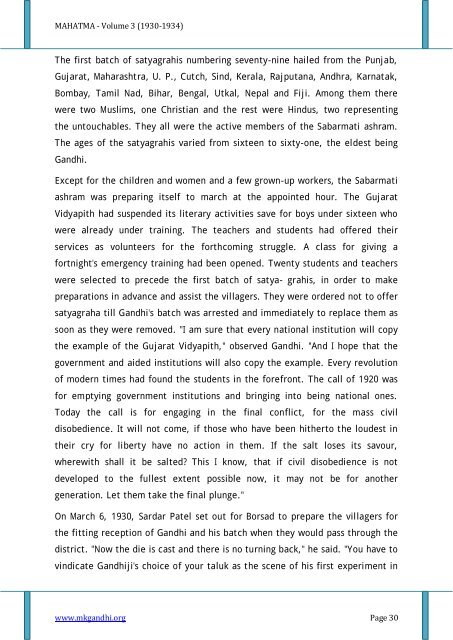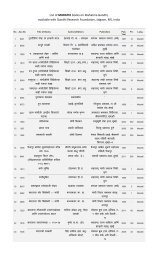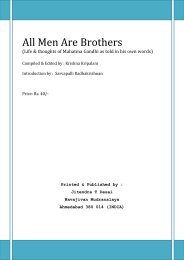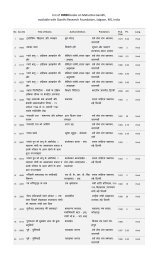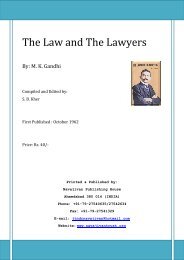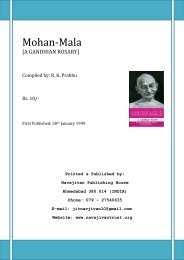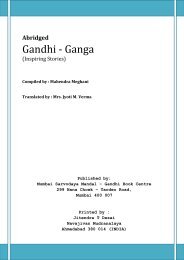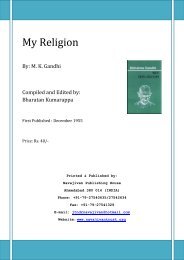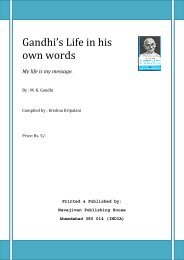- Page 1 and 2: MAHATMA Volume 3 [1930-1934] By: D.
- Page 3 and 4: MAHATMA - Volume 3 (1930-1934) 01.
- Page 5 and 6: MAHATMA - Volume 3 (1930-1934) far
- Page 7 and 8: MAHATMA - Volume 3 (1930-1934) ever
- Page 9 and 10: MAHATMA - Volume 3 (1930-1934) unne
- Page 11 and 12: MAHATMA - Volume 3 (1930-1934) Gove
- Page 13 and 14: MAHATMA - Volume 3 (1930-1934) "We
- Page 15 and 16: MAHATMA - Volume 3 (1930-1934) Shaf
- Page 17 and 18: MAHATMA - Volume 3 (1930-1934) whic
- Page 19 and 20: MAHATMA - Volume 3 (1930-1934) unde
- Page 21 and 22: MAHATMA - Volume 3 (1930-1934) exem
- Page 23 and 24: MAHATMA - Volume 3 (1930-1934) wort
- Page 25 and 26: MAHATMA - Volume 3 (1930-1934) itse
- Page 27 and 28: MAHATMA - Volume 3 (1930-1934) the
- Page 29: MAHATMA - Volume 3 (1930-1934) 02.
- Page 33 and 34: MAHATMA - Volume 3 (1930-1934) what
- Page 35 and 36: MAHATMA - Volume 3 (1930-1934) alwa
- Page 37 and 38: MAHATMA - Volume 3 (1930-1934) seek
- Page 39 and 40: MAHATMA - Volume 3 (1930-1934) so l
- Page 41 and 42: MAHATMA - Volume 3 (1930-1934) on b
- Page 43 and 44: MAHATMA - Volume 3 (1930-1934) humi
- Page 45 and 46: MAHATMA - Volume 3 (1930-1934) are
- Page 47 and 48: MAHATMA - Volume 3 (1930-1934) "I h
- Page 49 and 50: MAHATMA - Volume 3 (1930-1934) To s
- Page 51 and 52: MAHATMA - Volume 3 (1930-1934) Gove
- Page 53 and 54: MAHATMA - Volume 3 (1930-1934) term
- Page 55 and 56: MAHATMA - Volume 3 (1930-1934) 03.
- Page 57 and 58: MAHATMA - Volume 3 (1930-1934) poss
- Page 59 and 60: MAHATMA - Volume 3 (1930-1934) the
- Page 61 and 62: MAHATMA - Volume 3 (1930-1934) The
- Page 63 and 64: MAHATMA - Volume 3 (1930-1934) make
- Page 65 and 66: MAHATMA - Volume 3 (1930-1934) Gand
- Page 67 and 68: MAHATMA - Volume 3 (1930-1934) powe
- Page 69 and 70: MAHATMA - Volume 3 (1930-1934) no s
- Page 71 and 72: MAHATMA - Volume 3 (1930-1934) The
- Page 73 and 74: MAHATMA - Volume 3 (1930-1934) 04.
- Page 75 and 76: MAHATMA - Volume 3 (1930-1934) The
- Page 77 and 78: MAHATMA - Volume 3 (1930-1934) them
- Page 79 and 80: MAHATMA - Volume 3 (1930-1934) hour
- Page 81 and 82:
MAHATMA - Volume 3 (1930-1934) The
- Page 83 and 84:
MAHATMA - Volume 3 (1930-1934) fort
- Page 85 and 86:
MAHATMA - Volume 3 (1930-1934) "We
- Page 87 and 88:
MAHATMA - Volume 3 (1930-1934) on m
- Page 89 and 90:
MAHATMA - Volume 3 (1930-1934) ther
- Page 91 and 92:
MAHATMA - Volume 3 (1930-1934) guar
- Page 93 and 94:
MAHATMA - Volume 3 (1930-1934) In t
- Page 95 and 96:
MAHATMA - Volume 3 (1930-1934) "And
- Page 97 and 98:
MAHATMA - Volume 3 (1930-1934) mean
- Page 99 and 100:
MAHATMA - Volume 3 (1930-1934) our
- Page 101 and 102:
MAHATMA - Volume 3 (1930-1934) excl
- Page 103 and 104:
MAHATMA - Volume 3 (1930-1934) 05.
- Page 105 and 106:
MAHATMA - Volume 3 (1930-1934) as s
- Page 107 and 108:
MAHATMA - Volume 3 (1930-1934) Bhag
- Page 109 and 110:
MAHATMA - Volume 3 (1930-1934) and
- Page 111 and 112:
MAHATMA - Volume 3 (1930-1934) mend
- Page 113 and 114:
MAHATMA - Volume 3 (1930-1934) tran
- Page 115 and 116:
MAHATMA - Volume 3 (1930-1934) "Wha
- Page 117 and 118:
MAHATMA - Volume 3 (1930-1934) pris
- Page 119 and 120:
MAHATMA - Volume 3 (1930-1934) happ
- Page 121 and 122:
MAHATMA - Volume 3 (1930-1934) comm
- Page 123 and 124:
MAHATMA - Volume 3 (1930-1934) "It
- Page 125 and 126:
MAHATMA - Volume 3 (1930-1934) 06.
- Page 127 and 128:
MAHATMA - Volume 3 (1930-1934) comm
- Page 129 and 130:
MAHATMA - Volume 3 (1930-1934) surr
- Page 131 and 132:
MAHATMA - Volume 3 (1930-1934) "But
- Page 133 and 134:
MAHATMA - Volume 3 (1930-1934) "I c
- Page 135 and 136:
MAHATMA - Volume 3 (1930-1934) On J
- Page 137 and 138:
MAHATMA - Volume 3 (1930-1934) "The
- Page 139 and 140:
MAHATMA - Volume 3 (1930-1934) with
- Page 141 and 142:
MAHATMA - Volume 3 (1930-1934) "Now
- Page 143 and 144:
MAHATMA - Volume 3 (1930-1934) jail
- Page 145 and 146:
MAHATMA - Volume 3 (1930-1934) trib
- Page 147 and 148:
MAHATMA - Volume 3 (1930-1934) "Tho
- Page 149 and 150:
MAHATMA - Volume 3 (1930-1934) Gand
- Page 151 and 152:
MAHATMA - Volume 3 (1930-1934) 07.
- Page 153 and 154:
MAHATMA - Volume 3 (1930-1934) me,
- Page 155 and 156:
MAHATMA - Volume 3 (1930-1934) "I a
- Page 157 and 158:
MAHATMA - Volume 3 (1930-1934) tact
- Page 159 and 160:
MAHATMA - Volume 3 (1930-1934) the
- Page 161 and 162:
MAHATMA - Volume 3 (1930-1934) of t
- Page 163 and 164:
MAHATMA - Volume 3 (1930-1934) prov
- Page 165 and 166:
MAHATMA - Volume 3 (1930-1934) when
- Page 167 and 168:
MAHATMA - Volume 3 (1930-1934) Trev
- Page 169 and 170:
MAHATMA - Volume 3 (1930-1934) dole
- Page 171 and 172:
MAHATMA - Volume 3 (1930-1934) dedi
- Page 173 and 174:
MAHATMA - Volume 3 (1930-1934) Shaw
- Page 175 and 176:
MAHATMA - Volume 3 (1930-1934) With
- Page 177 and 178:
MAHATMA - Volume 3 (1930-1934) "The
- Page 179 and 180:
MAHATMA - Volume 3 (1930-1934) "Tha
- Page 181 and 182:
MAHATMA - Volume 3 (1930-1934) An A
- Page 183 and 184:
MAHATMA - Volume 3 (1930-1934) "Yes
- Page 185 and 186:
MAHATMA - Volume 3 (1930-1934) aid
- Page 187 and 188:
MAHATMA - Volume 3 (1930-1934) stoo
- Page 189 and 190:
MAHATMA - Volume 3 (1930-1934) "The
- Page 191 and 192:
MAHATMA - Volume 3 (1930-1934) was
- Page 193 and 194:
MAHATMA - Volume 3 (1930-1934) soci
- Page 195 and 196:
MAHATMA - Volume 3 (1930-1934) On T
- Page 197 and 198:
MAHATMA - Volume 3 (1930-1934) the
- Page 199 and 200:
MAHATMA - Volume 3 (1930-1934) has
- Page 201 and 202:
MAHATMA - Volume 3 (1930-1934) "I a
- Page 203 and 204:
MAHATMA - Volume 3 (1930-1934) On D
- Page 205 and 206:
MAHATMA - Volume 3 (1930-1934) that
- Page 207 and 208:
MAHATMA - Volume 3 (1930-1934) with
- Page 209 and 210:
MAHATMA - Volume 3 (1930-1934) "I h
- Page 211 and 212:
MAHATMA - Volume 3 (1930-1934) "The
- Page 213 and 214:
MAHATMA - Volume 3 (1930-1934) dete
- Page 215 and 216:
MAHATMA - Volume 3 (1930-1934) fell
- Page 217 and 218:
MAHATMA - Volume 3 (1930-1934) mean
- Page 219 and 220:
MAHATMA - Volume 3 (1930-1934) stat
- Page 221 and 222:
MAHATMA - Volume 3 (1930-1934) publ
- Page 223 and 224:
MAHATMA - Volume 3 (1930-1934) "As
- Page 225 and 226:
MAHATMA - Volume 3 (1930-1934) "Fas
- Page 227 and 228:
MAHATMA - Volume 3 (1930-1934) elec
- Page 229 and 230:
MAHATMA - Volume 3 (1930-1934) matt
- Page 231 and 232:
MAHATMA - Volume 3 (1930-1934) plan
- Page 233 and 234:
MAHATMA - Volume 3 (1930-1934) the
- Page 235 and 236:
MAHATMA - Volume 3 (1930-1934) frie
- Page 237 and 238:
MAHATMA - Volume 3 (1930-1934) thro
- Page 239 and 240:
MAHATMA - Volume 3 (1930-1934) Gand
- Page 241 and 242:
MAHATMA - Volume 3 (1930-1934) soul
- Page 243 and 244:
MAHATMA - Volume 3 (1930-1934) 11.
- Page 245 and 246:
MAHATMA - Volume 3 (1930-1934) 'unt
- Page 247 and 248:
MAHATMA - Volume 3 (1930-1934) have
- Page 249 and 250:
MAHATMA - Volume 3 (1930-1934) disa
- Page 251 and 252:
MAHATMA - Volume 3 (1930-1934) not
- Page 253 and 254:
MAHATMA - Volume 3 (1930-1934) sugg
- Page 255 and 256:
MAHATMA - Volume 3 (1930-1934) dyin
- Page 257 and 258:
MAHATMA - Volume 3 (1930-1934) Gand
- Page 259 and 260:
MAHATMA - Volume 3 (1930-1934) resi
- Page 261 and 262:
MAHATMA - Volume 3 (1930-1934) unto
- Page 263 and 264:
MAHATMA - Volume 3 (1930-1934) dist
- Page 265 and 266:
MAHATMA - Volume 3 (1930-1934) feel
- Page 267 and 268:
MAHATMA - Volume 3 (1930-1934) Rema
- Page 269 and 270:
MAHATMA - Volume 3 (1930-1934) 13.
- Page 271 and 272:
MAHATMA - Volume 3 (1930-1934) die
- Page 273 and 274:
MAHATMA - Volume 3 (1930-1934) save
- Page 275 and 276:
MAHATMA - Volume 3 (1930-1934) Raja
- Page 277 and 278:
MAHATMA - Volume 3 (1930-1934) The
- Page 279 and 280:
MAHATMA - Volume 3 (1930-1934) On M
- Page 281 and 282:
MAHATMA - Volume 3 (1930-1934) Kast
- Page 283 and 284:
MAHATMA - Volume 3 (1930-1934) sugg
- Page 285 and 286:
MAHATMA - Volume 3 (1930-1934) crys
- Page 287 and 288:
MAHATMA - Volume 3 (1930-1934) with
- Page 289 and 290:
MAHATMA - Volume 3 (1930-1934) that
- Page 291 and 292:
MAHATMA - Volume 3 (1930-1934) am d
- Page 293 and 294:
MAHATMA - Volume 3 (1930-1934) Jawa
- Page 295 and 296:
MAHATMA - Volume 3 (1930-1934) woul
- Page 297 and 298:
MAHATMA - Volume 3 (1930-1934) obse
- Page 299 and 300:
MAHATMA - Volume 3 (1930-1934) the
- Page 301 and 302:
MAHATMA - Volume 3 (1930-1934) that
- Page 303 and 304:
MAHATMA - Volume 3 (1930-1934) inst
- Page 305 and 306:
MAHATMA - Volume 3 (1930-1934) Hind
- Page 307 and 308:
MAHATMA - Volume 3 (1930-1934) enli
- Page 309 and 310:
MAHATMA - Volume 3 (1930-1934) comp
- Page 311 and 312:
MAHATMA - Volume 3 (1930-1934) full
- Page 313 and 314:
MAHATMA - Volume 3 (1930-1934) To t
- Page 315 and 316:
MAHATMA - Volume 3 (1930-1934) 16.
- Page 317 and 318:
MAHATMA - Volume 3 (1930-1934) as I
- Page 319 and 320:
MAHATMA - Volume 3 (1930-1934) On D
- Page 321 and 322:
MAHATMA - Volume 3 (1930-1934) ours
- Page 323 and 324:
MAHATMA - Volume 3 (1930-1934) "Ear
- Page 325 and 326:
MAHATMA - Volume 3 (1930-1934) a pu
- Page 327 and 328:
MAHATMA - Volume 3 (1930-1934) appe
- Page 329 and 330:
MAHATMA - Volume 3 (1930-1934) Hind
- Page 331 and 332:
MAHATMA - Volume 3 (1930-1934) dist
- Page 333 and 334:
MAHATMA - Volume 3 (1930-1934) the
- Page 335 and 336:
MAHATMA - Volume 3 (1930-1934) by o
- Page 337 and 338:
MAHATMA - Volume 3 (1930-1934) for
- Page 339 and 340:
MAHATMA - Volume 3 (1930-1934) scep
- Page 341 and 342:
MAHATMA - Volume 3 (1930-1934) 18.
- Page 343 and 344:
MAHATMA - Volume 3 (1930-1934) peop
- Page 345 and 346:
MAHATMA - Volume 3 (1930-1934) From
- Page 347 and 348:
MAHATMA - Volume 3 (1930-1934) of t
- Page 349 and 350:
MAHATMA - Volume 3 (1930-1934) Gove
- Page 351 and 352:
MAHATMA - Volume 3 (1930-1934) resi
- Page 353 and 354:
MAHATMA - Volume 3 (1930-1934) of t
- Page 355 and 356:
MAHATMA - Volume 3 (1930-1934) not
- Page 357 and 358:
MAHATMA - Volume 3 (1930-1934) Bidh
- Page 359 and 360:
MAHATMA - Volume 3 (1930-1934) keep
- Page 361 and 362:
MAHATMA - Volume 3 (1930-1934) into
- Page 363 and 364:
MAHATMA - Volume 3 (1930-1934) beco
- Page 365 and 366:
MAHATMA - Volume 3 (1930-1934) shie
- Page 367 and 368:
MAHATMA - Volume 3 (1930-1934) Gand
- Page 369 and 370:
MAHATMA - Volume 3 (1930-1934) for
- Page 371 and 372:
MAHATMA - Volume 3 (1930-1934) visi
- Page 373 and 374:
MAHATMA - Volume 3 (1930-1934) "Sin
- Page 375 and 376:
MAHATMA - Volume 3 (1930-1934) bomb
- Page 377 and 378:
MAHATMA - Volume 3 (1930-1934) Gand
- Page 379 and 380:
MAHATMA - Volume 3 (1930-1934) pers
- Page 381 and 382:
MAHATMA - Volume 3 (1930-1934) plat
- Page 383 and 384:
MAHATMA - Volume 3 (1930-1934) 21.
- Page 385 and 386:
MAHATMA - Volume 3 (1930-1934) the
- Page 387 and 388:
MAHATMA - Volume 3 (1930-1934) "As
- Page 389 and 390:
MAHATMA - Volume 3 (1930-1934) the
- Page 391 and 392:
MAHATMA - Volume 3 (1930-1934) "It
- Page 393 and 394:
MAHATMA - Volume 3 (1930-1934) "The
- Page 395 and 396:
MAHATMA - Volume 3 (1930-1934) give
- Page 397 and 398:
MAHATMA - Volume 3 (1930-1934) more
- Page 399 and 400:
MAHATMA - Volume 3 (1930-1934) I se
- Page 401 and 402:
MAHATMA - Volume 3 (1930-1934) "The
- Page 403 and 404:
MAHATMA - Volume 3 (1930-1934) my c
- Page 405 and 406:
MAHATMA - Volume 3 (1930-1934) "I p
- Page 407 and 408:
MAHATMA - Volume 3 (1930-1934) demo
- Page 409 and 410:
MAHATMA - Volume 3 (1930-1934) On t
- Page 411 and 412:
MAHATMA - Volume 3 (1930-1934) reit
- Page 413 and 414:
MAHATMA - Volume 3 (1930-1934) www.
- Page 415 and 416:
MAHATMA - Volume 3 (1930-1934) www.
- Page 417 and 418:
MAHATMA - Volume 3 (1930-1934) www.
- Page 419 and 420:
MAHATMA - Volume 3 (1930-1934) www.
- Page 421 and 422:
MAHATMA - Volume 3 (1930-1934) www.
- Page 423 and 424:
MAHATMA - Volume 3 (1930-1934) www.
- Page 425 and 426:
MAHATMA - Volume 3 (1930-1934) www.
- Page 427 and 428:
MAHATMA - Volume 3 (1930-1934) www.
- Page 429 and 430:
MAHATMA - Volume 3 (1930-1934) the
- Page 431 and 432:
MAHATMA - Volume 3 (1930-1934) of c
- Page 433 and 434:
MAHATMA - Volume 3 (1930-1934) With
- Page 435 and 436:
MAHATMA - Volume 3 (1930-1934) comp
- Page 437 and 438:
MAHATMA - Volume 3 (1930-1934) Anan
- Page 439 and 440:
MAHATMA - Volume 3 (1930-1934) mean
- Page 441 and 442:
MAHATMA - Volume 3 (1930-1934) This
- Page 443 and 444:
MAHATMA - Volume 3 (1930-1934) you
- Page 445 and 446:
MAHATMA - Volume 3 (1930-1934) kept
- Page 447:
MAHATMA - Volume 3 (1930-1934) me a


